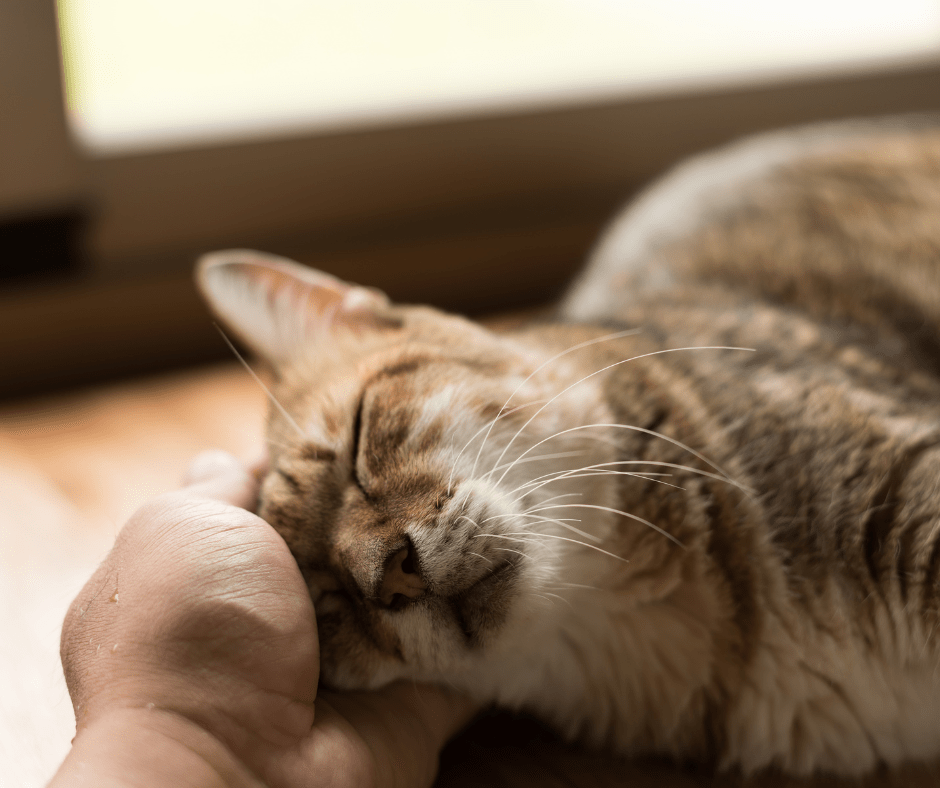Cats in their Senior Years – Supporting Common Conditions

Sadly, our kitties don’t stay young forever, and as old age creeps in, health concerns can too. This can be a worrying time, with many cat owners unsure how best to support their pets. We are going to look at some of the most common conditions to affect our senior feline friends, and what pet owners can do to help.
What are the ‘senior years’ in cats?
Cats tend to be classed as seniors when they are between 11 and 14 years of age (and super seniors once over the age of 15!).
When working out what a cat would be in human years we use the following logic –
The first 2 years of a cat’s life are equivalent to 24 human years, and every year thereafter is equivalent to 4 human years.
This means that an 11-year-old cat is 60 in human years and a 14 -year-old cat would be 72 in human years. Simply working out their cat’s age in human terms helps some owners manage their expectations around their cat’s health and think about their care needs accordingly.
Common senior conditions
Most senior pets will need care adjustments of some sort, usually diet and exercise-related, but if your cat develops a health condition then you may need to be even more proactive. Here are some of the most common senior conditions in felines and some tips on your pet’s care.
Chronic kidney disease
Chronic kidney disease (CKD) is a condition that affects many senior cats. In most cats, the exact cause of the disease is unknown, but over time healthy kidney tissue has become replaced by scar tissue. Kidney function becomes impaired, meaning that toxic waste products are not filtered out of the blood and water is not properly conserved. This leads to cats becoming unwell with symptoms such as reduced appetite, weight loss, excessive thirst, excessive urination and lethargy.
If your cat is diagnosed with this condition, they initially may require intravenous fluids at the vets to correct any dehydration. Once stable you can support them at home through a change of diet and encouraging fluid intake. Cats with CKD often benefit from a moderately reduced protein diet and always from restricted phosphate, which can be achieved through a specially formulated kidney diet.
Cats with kidney disease are also prone to dehydration, so encouraging water intake with wet food and plenty of fresh drinking water is important. Water fountains can help entice some cats into drinking or try adding a couple of spoons of water to each of your cat’s meals.
Your vet may advise you on medications to help with other CKD-related issues, such as high blood pressure or nausea.
Hyperthyroidism
Hyperthyroidism is caused by a benign tumour in your cat’s thyroid gland. This causes an overproduction of thyroid hormones, the chemical signals responsible for many functions around the body, including metabolism. Affected cats will usually lose weight despite having a very good appetite, and may show other symptoms like vomiting, diarrhoea and hyperactivity. Left untreated, issues associated with high blood pressure can cause damage to organs like the eyes and kidneys, and dramatic changes in heart function, leading to cardiomyopathy.
There are a variety of treatment options available for hyperthyroidism, which you should discuss with your vet. The best way to support your cat is to choose one of these treatment options and follow your vet’s guidance. Treatment usually brings things under control, with your cat starting to gain weight and feel better in themselves.
Diabetes mellitus
Cats with diabetes mellitus need to be cared for under close veterinary supervision. Patients often require regular insulin supplementation to manage their blood sugar levels, as their bodies are not producing enough insulin of their own. A change in diet is usually advisable, with cats that go into remission being managed through diet alone.
In addition to following your vet’s guidance, you can further support your diabetic senior by keeping a close watch on any changes to their condition. Diabetic cats are prone to many complications including urinary tract infections, diabetic retinopathy (causing blindness), hypoglycaemia (low blood sugar) and diabetic ketoacidosis (a serious metabolic condition caused by uncontrolled blood sugar levels).
Monitoring your cat’s thirst and urination habits for any changes is key, as well as keeping an eye on their appetite and weight. If your pet goes blind from diabetes, you can further support them by making sensible adjustments in the home. Cats have a great sense of hearing, smell and touch, so keeping the furniture in your home in predictable places and talking to your pet to let them know you are approaching will help a lot.
Cancer
Cancer is a very broad term that covers an array of different conditions, most of which are more common in older cats. Some types of cancer may be localised and benign. However, other cancers can be more sinister, growing rapidly or spreading to different regions of the body. Cancer can be obvious when it’s an external lump, but internal problems can be harder to spot. That’s where keeping an eye on your pet’s weight, appetite, thirst and toileting behaviour can help.
If you notice something suspicious, get your vet to check it out. By acting early, the condition may be more treatable. However, if your cat has advanced disease then palliative care is key. This means making sure that their pain levels are well managed and that they are still eating and drinking normally.
Heart disease
Heart disease is much more common in middle-aged or senior cats, than younger ones. The most common heart condition diagnosed is hypertrophic cardiomyopathy (HCM). With this disease, the heart muscle becomes abnormally thickened, meaning the chambers (spaces within the heart) become smaller. This stops them from being able to fill and pump blood as effectively.
Some cats with heart disease may show no symptoms at all, especially in the early stages of the disease. Subtle changes, such as not exercising as much as usual, can go unnoticed or be put down to ‘old age’. As the disease advances, other symptoms such as breathing difficulties, reduced appetite, swollen abdomen, weight loss and behavioural changes might be seen. Sometimes a problem will be detected after a murmur is heard at a routine examination; others will not be diagnosed until they present in an emergency.
Unfortunately, this condition cannot be cured unless it is secondary to hyperthyroidism, but sometimes medication can help. Monitoring your cat closely for changes and seeking urgent help is crucial to supporting these cats.
Osteoarthritis
Osteoarthritis in cats is often undetected by owners and vets alike. Cats with arthritis are very good at hiding their discomfort, so symptoms can be subtle. Osteoarthritis is a progressive, degenerative disease that creeps on gradually. It occurs due to ageing or wear and tear, as well as underlying joint abnormalities. In affected animals, the cartilage (shock absorber) in the joint becomes worn away, leading to inflammation and may even result in bone rubbing against bone. This discomfort may have slowly increased over a long period, meaning that affected cats don’t tend to cry out but may instead show signs like limping, increased grumpiness and stiffness, or reluctance to climb or jump.
It can be easy to dismiss signs like sleeping more or lack of grooming as just ‘old age’, but some of these more subtle cues can indicate chronic pain. Joint supplements can be helpful, but many cats will need prescribed pain relief or anti-inflammatories, especially as the disease advances.
Keeping your pet at a healthy weight will also reduce pressure on the joints, so the correct diet is important for these cats. There are many things you can do around the house too, such as providing your cat with steps to get up onto the bed or sofa more easily and using lower-sided litter trays so that it doesn’t take a big stretch to get into their litter tray. Also, think about horizontal scratch mats instead of a vertical scratch post. Ensuring your cat has a warm comfortable bed and regular gentle grooming will also help, just be careful not to be too rough with painful joints.
Cognitive dysfunction
Cognitive dysfunction (feline dementia) can affect senior cats. This decline in brain function can lead to symptoms such as increased vocalisation, pacing, confusion, inappropriate toileting and staring into space. This can be disruptive for human owners, especially if their cat is yowling in the middle of the night, but also unsettling for the cats themselves.
It is important to rule out other health conditions first, but if your cat is diagnosed with cognitive dysfunction then you can take steps to help. You can support your cat by feeding them ‘brain-boosting’ supplements or diets. Speak to your vet for their recommendations, but products usually include increased levels of antioxidants and omega-3 fatty acids. Some drugs have been anecdotally reported to help, but nothing has been specifically licensed for this use in cats yet. You should also keep your cat’s environment and routine as settled as possible. Big changes can be very distressing for these cats. Spend plenty of time, gently interacting with them and make sure that your cat has somewhere cosy and den-like to sleep.
Quality of Life
When managing your cat’s health condition, you must always consider their quality of life. If your pet can do the things they normally enjoy, like exercising, playing and eating, then these are all good signs. If, however, your cat is having increasing numbers of bad days, then this needs to be questioned.
Speaking with your vet is important, as there may be alternative treatment or management techniques that can help improve the situation. But if you feel you have exhausted all the options, or if you are no longer able to cope emotionally or financially with your cat’s condition, then euthanasia may be the kindest option.
If you are struggling to know what to do, then have a look at our ‘Is it time?’ page. We have a checklist that you can work through which will help you to assess your cat’s quality of life in more detail. You can also get in touch with one of our care co-ordinators.
Summary
Age brings with it a certain set of challenges, which can be a struggle for both owner and pet alike. By understanding common senior health conditions and providing the right level of support for your elderly cat, you can make a real difference to their wellbeing.
If you have any concerns about your cat’s quality of life, then make sure you speak to your vet or contact us for further advice.
Cloud 9
To ensure accuracy, a professional vet has reviewed and verified the information presented in this article. It is important to note that when it comes to making decisions about euthanasia for your pet, there are no easy answers. It is always recommended to seek advice from your own veterinarian before making any decision.


